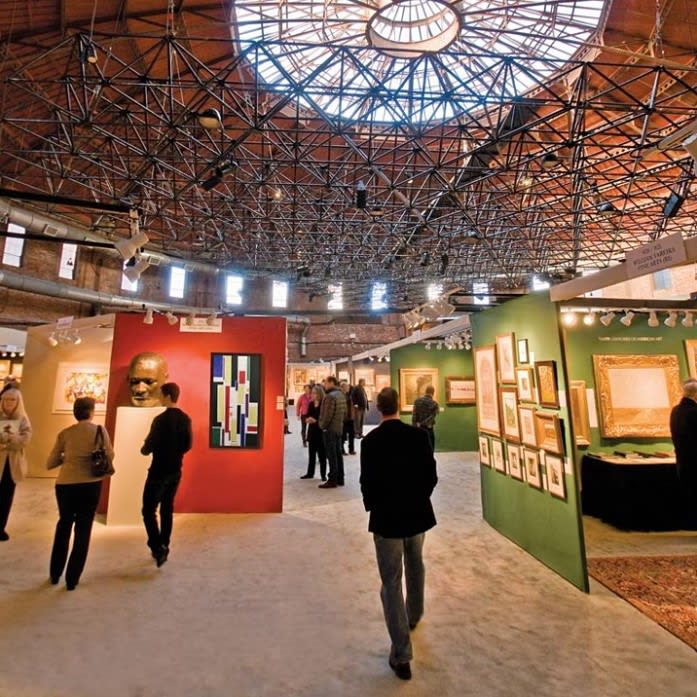Known for his use of expressive and uninhibited color, Arthur B. Carles explored modernist principles without following a particular formula. At times, he arrived at artistic innovations in advance of other painters of his day. Considered a precursor of the Abstract Expressionists, he and his work were respected and admired by major critics and fellow artists including Hans Hofmann. He was recognized by ARTNews as one of the most important art teachers in America.
Born in Philadelphia on March 9, 1882, Arthur Beecher Carles, Jr., may have received his first artistic instruction from his father, who was a designer and amateur artist. As a young man, Carles studied at the Pennsylvania Academy of the Fine Arts between 1900 and 1907. His teachers—among them Thomas Anshutz, Hugh Breckenridge, Henry McCarter, Cecilia Beaux, and William Merritt Chase—were inspired by modern French painting and all stressed color and design to varying degrees. In 1903, Carles won the Henry P. Thouron Prize for best student composition and participated in the Philadelphia Watercolor Exhibition. Two years later, Carles was awarded the William Emlen Cresson Traveling Scholarship. Accompanied by artist friend George Oberteuffer, he visited London, Paris, and possibly Chase's class in Madrid.
In 1907, Carles embarked on another extended stay in France provided by the two-year Cresson scholarship. John Trask, director of the Academy, took a special interest in Carles and arranged for a commission from a Philadelphia church for a copy of Raphael's Transfiguration in the Vatican. Trask was later instrumental in placing the artist's work in the Panama-Pacific Exposition of 1915, where Carles won a silver medal for White Nude with Apple.
Carles stayed in Paris until 1910, immersing himself in the newest trends in art. He visited Leo and Gertrude Stein's salon and associated with other American artists such as John Marin and Edward Steichen. Carles was particularly attracted to the work of Paul Cezanne and Henri Matisse, and his canvases from this period reveal Matisse's influence. In March 1910, through Edward Steichen's intervention, Carles's work was included in the "Younger American Painters" show held at Alfred Stieglitz's New York gallery, 291. In its review of the show, the Philadelphia Inquirer remarked of Carles, "he represents more ably and fully than anyone else at present working in America the spirit of the new or modern movement in art in France today." Stieglitz gave Carles his first one-man show at 291 in January 1912. The following June, Carles returned to Voulangis, the village outside of Paris where the Steichens lived.
Carles returned from France in December 1912 with several landscapes, two of which he exhibited at the Armory Show of 1913. He painted still lifes with Breckenridge in which they used similar objects, and their compositions are almost indiscernible in style. By this time, Carles was a confirmed modernist and he became a fervent spokesman for modern art in Philadelphia. During this period, Carles also painted his only major allegorical piece, The Marseillaise (Philadelphia Museum of Art), inspired by his love of France. When exhibited at the Academy's annual exhibition of 1919, the painting took the Stotesbury Prize and the Fellowship Prize, and it was hung in the Place of Honor.
Carles was instrumental in organizing three exhibitions at the Pennsylvania Academy in Philadelphia with the help of Stieglitz and others and the encouragement of his friend Leopold Stokowski, the conductor of the Philadelphia Symphony Orchestra. His efforts took place in the context of the city's cultural renaissance of the teens and 1920s. The 1923 exhibition of European modernist paintings from the collection of Dr. Albert C. Barnes provoked particularly strong reactions. Carles also played an influential role as a teacher of younger artists. He taught the Saturday morning Sketch Class at the Academy from 1917 to 1925 and taught privately afterwards.
Carles lived in France for part of a year spanning 1921 and 1922, and for two years between 1929 and 1931. During this decade, he began experimenting with breaking up forms with cubist planes of color. After his return to the United States, he renewed his friendship with Hans Hofmann, whom he had met years before in Paris. He shared Hofmann's love for Fauvist color and interest in Cubist space. The two artists, accompanied by Carles's daughter Mercedes, who was Hofmann's pupil, lived together in Gloucester, Massachusetts during the summer of 1934.
In the last phase of his career, Carles painted a number of ambitious abstract compositions, despite repeated hospitalizations for alcoholism. His life as an artist drew to an abrupt close in December 1941 with a fall and stroke that left him an invalid until his death in 1952.
Carles is represented in major public collections, including the Metropolitan Museum of Art, the Whitney Museum of American Art, and the Museum of Modern Art, all in New York; the Newark Museum, New Jersey; the Baltimore Museum of Art; the Phillips Collection, the Hirshhorn Museum and Sculpture Garden, and the Corcoran Gallery of Art, all in Washington, D.C.; the Pennsylvania Academy of the Fine Arts and the Philadelphia Museum of Art in Philadelphia; and the Art Institute of Chicago.



